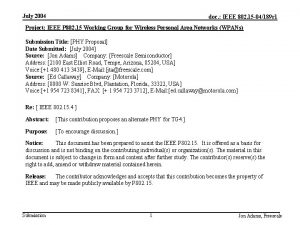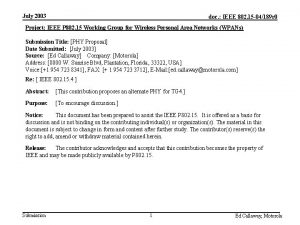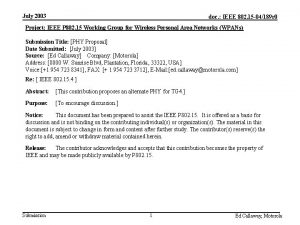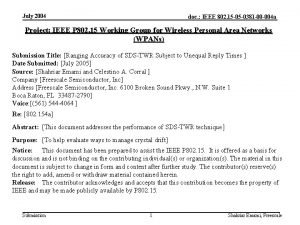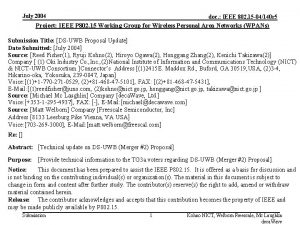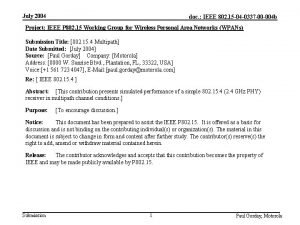July 2004 doc IEEE 802 15 04189 r










- Slides: 10

July 2004 doc. : IEEE 802. 15 -04/189 r 1 Project: IEEE P 802. 15 Working Group for Wireless Personal Area Networks (WPANs) Submission Title: [PHY Proposal] Date Submitted: [July 2004] Source: [Jon Adams] Company: [Freescale Semiconductor] Address: [2100 East Elliot Road, Tempe, Arizona, 85284, USA] Voice: [+1 480 413 3439], E-Mail: [jta@freescale. com] Source: [Ed Callaway] Company: [Motorola] Address: [8000 W. Sunrise Blvd, Plantation, Florida, 33322, USA] Voice: [+1 954 723 8341], FAX: [+ 1 954 723 3712], E-Mail: [ed. callaway@motorola. com] Re: [ IEEE 802. 15. 4 ] Abstract: [This contribution proposes an alternate PHY for TG 4. ] Purpose: [To encourage discussion. ] Notice: This document has been prepared to assist the IEEE P 802. 15. It is offered as a basis for discussion and is not binding on the contributing individual(s) or organization(s). The material in this document is subject to change in form and content after further study. The contributor(s) reserve(s) the right to add, amend or withdraw material contained herein. Release: The contributor acknowledges and accepts that this contribution becomes the property of IEEE and may be made publicly available by P 802. 15. Submission 1 Jon Adams, Freescale

July 2004 doc. : IEEE 802. 15 -04/189 r 1 Forces on TG 4 since the 11/00 PAR-1 • European expansion of 868 MHz band in process • The “Banding Branding” Problem: Potential market confusion between the two existing PHYs difficult to overcome; may affect investment in the industry • 1% duty cycle of present 868 MHz band limits throughput and sleep time with present low data rate PHY Submission 2 Jon Adams, Freescale

July 2004 doc. : IEEE 802. 15 -04/189 r 1 Forces on TG 4 since the 11/00 PAR-2 • Additional WPAN applications (consumer remote control displaying channel, audio or low resolution video capture; security systems displaying low quality still image capture, 16 kbps encoded audio for voice recognition remotes, PC peripherals, toys, games, and automation and control systems) have been identified by Zig. Bee, that cannot be served by the existing 20/40 kb/s data rate. • Chip vendors have informally proposed nonstandard “dual band” chips, using 2. 4 GHz modulation scheme at 915 MHz, to get higher data rates there. Submission 3 Jon Adams, Freescale

July 2004 doc. : IEEE 802. 15 -04/189 r 1 Other Markets May Be Opening Up • Creation of new band segments in the 850 to 930 MHz for control/sensor systems like 15. 4 – PR China working on potentially 10 MHz somewhere between 850 -900 MHz – Taiwan, Korea, Japan considering similar – Other countries will follow suit as the first major markets open up • Sub-1 GHz will become increasingly important as these bands open up Submission 4 Jon Adams, Freescale

July 2004 doc. : IEEE 802. 15 -04/189 r 1 Proposal • Allow the current 802. 15. 4 2. 4 GHz PHY modulation scheme to be used optionally on the 865 -868. 6 MHz and 902 -928 MHz bands, but at half the chip rate: – A single 125 kb/s channel centered at 866. 8 MHz – Ten 125 kb/s channels at 906, 908, 910, 912, 914, 916, 918, 920, 922, 924 MHz Submission 5 Jon Adams, Freescale

July 2004 doc. : IEEE 802. 15 -04/189 r 1 Spectral Plot of 0 d. Bm 125 kb/s Signal Submission 6 Jon Adams, Freescale

July 2004 doc. : IEEE 802. 15 -04/189 r 1 Adjacent Channel Spectra Submission 7 Jon Adams, Freescale

July 2004 doc. : IEEE 802. 15 -04/189 r 1 Features of Our Proposal-1 • A multiband TG 4 transceiver becomes much easier to build. Such a device could eliminate interoperability problems and resulting market confusion. • Users of the 902 -928 MHz band get a 3 x increase in data rate, without a reduction in the number of available channels. Submission 8 Jon Adams, Freescale

July 2004 doc. : IEEE 802. 15 -04/189 r 1 Features of Our Proposal-2 • Advantage is taken of the expanded 868 MHz band, giving European users a 6 x increase in data rate. • Economy of scale, greater purchasing leverage via reduced sourcing costs, and faster design cycle benefits are gained by the OEM. • Modulation scheme is well understood, already developed in working, commercial products so time to market is minimal Submission 9 Jon Adams, Freescale

July 2004 doc. : IEEE 802. 15 -04/189 r 1 Channel Numbering Methods • Current numbering scheme for 15. 4 channels cannot go forward without much confusion • Need to come up with a better, potentially “frequency” based-channel numbering scheme • Would like to see a clear proposal on this over the next two months Submission 10 Jon Adams, Freescale











